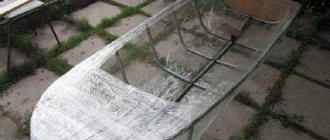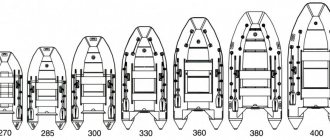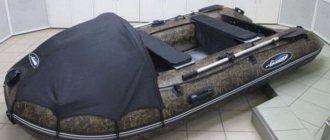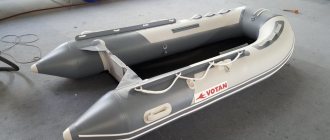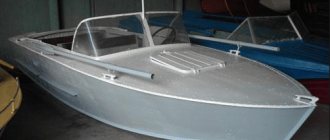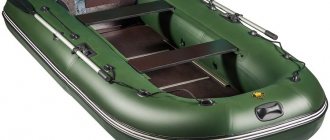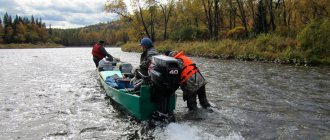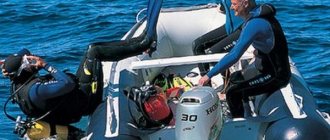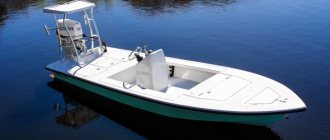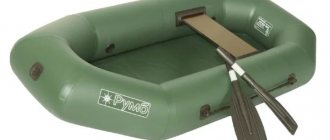Kazanka version 6 stands out sharply from the general series of the factory series. It, like the Kazanka 6M, is intended for recreation on the water, fishing and simple hunting, walking, and agricultural needs. Used in small closed reservoirs: lakes, ponds, reservoirs.
It is characterized by low stability, lightness and average driving performance. However, it planes well thanks to the flat bottom and johnboat design. Thus, the manufacturer took care of consumers who need motorized vehicles for leisurely trips under PM of moderate power, without pretensions to comfortable long-distance tourist trips.
Flaws
- Duralumin was a good material in its time. Its advantages include elasticity, which prevents the appearance of dents. However, this metal is connected exclusively by riveting. This requires periodic investment of time and effort, which is irrelevant in motorboats made of AMG or plastic.
- Low speed compared to other modifications
- An extremely weak bottom, which inevitably begins to leak and rot over time
- Dolphinization during excitement and fast driving
- Shipowners have comments regarding the strength of the sub-keys, which are torn from the hull during operation
- Plywood linings on cans are subject to the influence of atmospheric phenomena and temperature changes; they soon creep apart and rot.
Photo of the boat Kazanka 6:
Technical characteristics of the boat "Kazanka-2"
“Kazanka-2” has become a rather serious modification, and is distinguished by the following characteristics:
- can carry up to eight people;
- can move through water with waves of three points;
- All the running parts of the boat have been significantly improved. It is capable of moving with a motor of fifty horsepower;
- the body is made of duralumin;
This model is designed for more serious walking on the water and can go further out to sea than previous versions.
History and goals of creation
Before the production of boats from the Kazanka 6 series, the aircraft plant named after. S.P. Gorbunov has already released more than 8 production models for sale. They were popular among the people not only because of mass sales, but also because of the careful study by the “Gorbunovites” of the comments and suggestions of shipowners. Thus, the need was identified for lightweight, but load-lifting and spacious utility rowing motorized boots, which could be combined with a low-power propulsion unit. To develop the project, the designers spent a long period studying foreign experience and the developments of Academician A. N. Krylov, as well as the recommendations of the Neptune Central Design Bureau.
They began rolling off the assembly line in 1985. Johnbot was not widespread then, as the buyer slowly adapted to the unexplored and new structure of the product. However, this form was ideal for mass, highly mechanized production. Demand for the product began to rise only in the second year of sales. As a result of the competition in Narva in 1986, the creators of the glider were awarded a 1st degree diploma for the high quality of manufacturing of motorized vessels. Before the production of motorboats at the plant was closed in 1995, it was possible to purchase various models from this series, including the sixth.
Video of the boat Kazanka 6:
Utility rowing motor boat "Kazanka-6"
Kazan Aviation Production Association named after. S.P. Gorbunova has been developing and manufacturing motor boats since 1957. The “Kazanka-M”, “Kazanka-MD”, “Kazanka-2”, “Kazanka-2M”, “Kazanka-5”, “Kazanka” produced over the years -5M1”, “Kazanka-5M2” are well known to all lovers of water tourism and water recreation. When creating new models of motorboats, the wishes of our numerous customers were generally always taken into account, who, based on their experience in operating boats and boats, recommended certain design improvements. And, as a rule, in subsequent models the original proposals were embodied in the design of the products.
Currently, consumer demand for expensive, comfortable motorboats has noticeably decreased. There was a need for light rowing vessels, which could also be operated with a low-power engine. The designers of the association, having studied foreign experience and taking into account the recommendations of the Central Research Institute named after. Academician A.N. Krylov and the Neptune Central Design Bureau, created a fundamentally new model of the Kazanka 6 boat.
Characteristics table
The characteristics of both modifications are similar, so they are brought together.
| Overall length, m | 4,4 |
| Maximum width, m | 1,32 |
| Side height at midship, m | 0,45 |
| Transom height, m | 0,38 |
| Bottom deadrise angle at transom | 0° |
| Weight with equipment and equipment, kg | 82 |
| Passenger capacity, persons | 3 |
| Load capacity, kg | 300 |
| Permissible PM power, l. With. | 12 |
| Permissible wave height, m | 0,2 |
| Housing material | D1AT |
| Assembly type | riveting |
Basic data
| Maximum length, m | 4,4 |
| Maximum width, m | 1,32 |
| Side height at midship, m | 0,45 |
| Transom height in DP, m | 0,38 |
| Passenger capacity, persons | 3 |
| Payload capacity, kg | 300 |
| Permissible power of outboard motor, l. With. | 12 |
| Travel speed with PM power 8 hp. With. at full displacement, km/h | at least 18 |
| Permissible wave height, m | 0,2 |
| Permissible distance from the shore, m | 500 |
| Weight with equipment, kg | 82 |
| Boat cost, rub | 220 |
"Kazanka-6" is a light rowing motor boat of the "johnboat" type with riveted construction. Its body is made of light aluminum alloy D1T. Like other boats of this type, Kazanka-6 has a flat bottom of constant width, a smoothly rising bow, an almost rectangular hull in plan with a significant camber of the sides. This form made it possible to develop a simple and technologically advanced body design designed for mass, highly mechanized production. The hull has practically no longitudinal frame, and the role of transverse force connections is performed by the bottom branches of U-shaped stamped frames. The power circuit of the case also includes three non-removable cans. Longitudinal ridge stampings (corrugations) give the necessary rigidity to the skin of the sides and bottom. On the bottom they also serve to stabilize the boat on course while moving. For ease of carrying, mooring and towing there are bow and stern handles.
The boat is protected from flooding in the event of an accident by buoyancy blocks made of foaming polystyrene, which fill the space under the cans. The hole can be repaired using the supplied repair kit. Waterproofness of rivet seams is ensured by laying sealing tape and thiokol putty. For the convenience of passengers, the metal surfaces of the cans are covered with plywood covers covered with vinyl leather.
The boat hull is painted in light colors with waterproof enamels of type HV-16 PVC with preliminary priming with primers of type GF-032, VL-02. “Kazanka-6” can float not only in freshwater bodies, but can also be used in seawater. If treated with care, the boat should last at least 15 years.
The extremely simple shape of the contours and the laconic design of the hull without a bow deck provide the consumer with ample opportunities for its use; “Kazanka-6,” we hope, will appeal not only to fishermen and hunters for its easy running and reliability, but will also be good for rural residents who always need a cheap and spacious utility boat for harvesting hay, firewood, and transporting household goods. The “Spartan” character of “Kazanka-6” does not require special conditions for its storage, it is easy to transport to another body of water, and it is convenient to approach a shallow shore.
The boat is equipped with two oars, a bailer for low water and a repair first aid kit.
The association began producing Kazanka-6 in 1985. Trade organizations traditionally treated new products with caution, but in 1986 the demand for the boat increased noticeably. The association has the ability to produce this model in quantities that fully satisfy the requests of trading organizations. We want Kazanka-6 to take its rightful place among its predecessors, which enjoy great consumer demand and well-deserved authority.
At last year's competition in Narva, for the prize of the magazine "Boats and Yachts", "Kazanka-6" successfully performed in the junior class of motor boats. For the high quality of production and based on the results of demonstration performances, its creators were awarded a 1st degree diploma "KYA".
Source: www.barque.ru
The rowing boat “Kazanka6M” is made of light duralumin alloys and is intended for use in fresh water in areas with temperate and cold climates at air temperatures from – 5C to + 50C and a wave height of no more than 0.2 m with a distance from the shore of no more than 0.5 km.
| TECHNICAL DATA | |
| Overall length, m. | 4.4 |
| Maximum length, m. | 4.3 |
| Overall width, m. | 1.36 |
| Maximum width, m. | 1.31 |
| Side height at midship, m. | 0.47 |
| Transom height in the center plane, m. | 0.38 |
| Passenger capacity, person | 3 |
| Useful load capacity, kg., no more | 300 |
| Maximum permissible power of outboard motor, kW/ (hp) | 8.8/(12hp) |
| Recommended outboard motor power kW/(hp) | 5.9 /(8hp) |
| The speed of the boat with an outboard motor of recommended power is 8 hp. at full displacement, not less than km/h | 18 |
| Boat life | 10 |
| EQUIPMENT | |
| Boat with buoyancy blocks, pcs. | 1 |
| Oar, pcs. | 2 |
| Repair package, kit. | 1 |
| Operating manual, pcs. | 1 |
BOAT CONSTRUCTION
The hull and bottom of the boat consist of molded duralumin sheets. The boat has: three rigid, non-removable seats (front, middle, and rear) included in the power circuit of the boat. As well as frames, bow and stern handles, used for carrying, mooring and towing the boat. A transom for an outboard motor with a short deadwood of ~15 inches (~381 mm), buoyancy blocks located under the seats, oars and shelves on the sides of the boat between the middle and rear seats for storing various accessories.
EXPLOITATION
When traveling on a boat with three oars, people sit on 3 seats of the boat, and it is recommended to place the load closer to the center of the boat. When traveling on a boat with two oars, people sit in the back and middle seats, while it is recommended to place the cargo between the front and middle seats. If there is one person in the boat, he occupies the middle seat, and the cargo is located between the middle rear seats. When operating a boat with an outboard motor, three people sit on 3 seats of the boat. When traveling on a boat with an outboard motor, one person steers the boat, and the other takes a seat in the middle seat, for better weight distribution of the boat. Regardless of the number of people in the boat, it is recommended to place the load closer to the center of the boat.
STORAGE RULES
The boat can be stored outdoors with the bottom up. To protect the paintwork from exposure to atmospheric precipitation, which is aggressive in the area where industrial enterprises are located, it is recommended to cover the bottom of the boat. Before long-term storage, it is necessary to restore the damaged paintwork on the body and parts. Storing a boat with a damaged coating can lead to destruction of the skin.
POSSIBLE MALFUNCTIONS AND WAYS TO ELIMINATE THEM
If the paintwork is damaged, restore it as follows: place the boat in a place protected from precipitation with the bottom facing up to ensure the highest quality performance; and dry. Remove loose paint and traces of corrosion (white coating) using sandpaper No. 170-200. Wipe the cleaned surface thoroughly to remove dust and other contaminants and degrease with gasoline or acetone. It is recommended to degrease twice, since the slightest traces of grease (even from sweaty hands) disrupt the adhesion of paint to metal. Dry for 15-20 minutes, prime and paint with waterproof enamel. After this, dry at a temperature not lower than +12C for at least 12 hours. If a leak is detected in the connections, remove the water and dry the surfaces. Coat the joints (cracks) with red lead diluted in drying oil or oil varnish, and dry at a temperature of +18C, +20C for 24 hours, and then cover the joints.
its 35mm from the edge of the outlined contour of the hole and mark the position of the rivets in a checkerboard pattern.
Drill holes with a diameter of 4.1 mm according to the markings. Clean the repaired casing and trim from dust, shavings and wipe with gasoline or acetone. Place sealing tape along the contour of the cutout and apply the trim. Puncture holes in the tape with an awl. Rivet the trim to the trim. Cover the repaired area of the cladding with primer and dry at a temperature of +18C, +20C for 30 hours. After this, paint this area with enamel and dry at the same temperature for 12 hours.
Source: vih.su
Appearance and design features
The main feature of the boat called Kazanka 6 is its johnboat-type structure. The frame is made of D1T alloy, suitable for use in fresh water. Sheathing thickness is 1.6-1.7 mm. The housing assembly technology is riveting; the butt seams are sealed with a gasket sealing tape coated with a layer of thiokol putty. The bottom is flat, the same across the entire width. The surface going towards the nose has a gradual smooth slope and a rectangular shape. There is significant camber in the sides.
6M has the same design and parameters. The only difference is that the rise in the nose is smoother than its predecessor. Its release began a little later. The longitudinal frame is weak, the rigidity of the boat depends on the bottom branches of the frames, stamped in the shape of the letter P. Additional strength is given by 3 stationary cans. And the sides and bottom are strengthened by ridge stampings. Thanks to them, the craft is maneuverable and stable on course.
There is no decked forepeak. Unsinkability is ensured by buoyancy blocks located under the seats, filled with foaming polystyrene. To make sitting more comfortable, they were covered with plywood overlays on top and covered with modern material - vinyl leatherette. Transporting and carrying the glider is facilitated by the presence of bow and stern handles.
The boat is primed with GF-032 or VL-02 solutions and painted with waterproof enamel HV-16, PVC. They prevent corrosion and can withstand even salty sea water. The transom is of a simple, non-self-draining shape. One PM is installed on a 20 mm plywood cover, covered with 3 mm duralumin, and is intended for a leg s 381 mm.
Habitability
The punt accommodates 3 people located on the bow, middle and stern cans. The width is sufficient so that passengers do not feel cramped. Inconvenience can be caused by splashes penetrating from the open nose.
Manufacturers did not provide any space for luggage. If necessary, boat owners cover the forepeak with a deck, under which a trunk is formed. The possibilities for tuning are quite extensive: installing a windshield, arches for hanging an awning, arranging comfortable seats with soft cushions and niches for tools.
Technical characteristics of the boat "Kazanka-M"
The changes that became a feature of this modification can be presented in the form of the following list:
- stern bulges were added to provide better buoyancy and stability on the water;
- a windshield was added;
- hard seats installed;
- the sub-engine niche was eliminated, which eliminated frequent flooding of the engine with water;
- the width of the boat has increased;
- The carrying capacity has increased slightly, but the passenger capacity has remained the same.
Characteristics of the boat "Kazanka-M"
Transporting a boat
Unlike other representatives of this series, this modification can be transported by car, as it is lightweight and compact in size. For a passenger car, the vessel is attached to the roof rails; for a truck with an open body, it is placed with emphasis on the cab.
At the same time, no one canceled transportation on a trailer. If this is the most optimal way, you should take care of purchasing a trailer that is suitable in size and carrying capacity. For ease of carrying, mooring or transporting the motorboat there are handles on the front and back. Two people can carry or load 82 kg.
The advantage of a johnboat is its shallow draft. In shallow water, it becomes an advantage: where another boat gets stuck with its keel, the punt comes right to the shore. At the same time, there is no need to balance on the forepeak and jump into the water. The open bow allows you to go straight out onto solid ground.
Ride quality
Kazanka version 6 rides well and planes in calm weather under 12-horsepower PM. The wave height is 0.2 m, the most optimal: high waves reduce the quality of the ride, lead to harsh dolphining and a decrease in speed. Placing a sandbag in the nose helps to improve the situation, thus reducing the danger of going into overkill.
The motorboat is great for hunting, fishing, walking or outdoor activities. Development zone: channels, canals and small lakes and rivers. The main advantage is the temperature range of its use: from –5° to +50° C. The manufacturer does not recommend going further than 500 m from the shore.
Under the motor
Both for version 6 and for the modification of Kazanka 6M. With a more uniform rise of the bottom to the bow, one PM is installed. With maximum displacement at 8 liters. With. The motorboat accelerates to 18 km/h.
Users see the transom in loose contact with the engine and “dangle” with it. To fix this, you need to strengthen the old transom board or use two instead, 20 mm thick and cover the outside with 3 mm duralumin. To accommodate a long leg, the sub-engine niche will have to be redone. According to reviews, the difference between a 2-stroke or 4-stroke engine for this model is imperceptible.
On the wave
The flat bow of the johnboat allows you to cope with low waves while maintaining normal stability. A flat bottom with a slight rise in the front can lead to planing. However, only in calm water and at low power. Otherwise, the move will be rough and a dolphin will appear.
Due to the weak bottom, the motorboat can leak while moving, so extreme sports on it are contraindicated. Going to sea is not prohibited by manufacturers; the hull is even covered with anti-corrosion compounds. But seaworthiness remains at a low level, since a motorized vessel is capable of going into overkill from both wind and waves. But for fishing and short walks in small areas of water, it is excellent. It will pass through overgrown surfaces, along muddy and shallow bottoms where keeled vessels have no access.
Main characteristics of the boat "Kazanka"
This vehicle can be briefly described as follows:
- can hold up to four hundred kilograms, which is equivalent to four passengers with fishing equipment;
- can go out to sea no further than one and a half kilometers and only in calm weather;
- quite unstable on the water due to the not particularly rational placement of partitions between the compartments;
- has a low draft, which contributes to successful planing;
- has high maneuverability, which is especially appreciated when moving along small rivers;
- the housing is sealed and made of duralumin;
- the maximum speed that the boat can reach is 40 kilometers per hour. When installing a more powerful motor, it is still not recommended to develop a higher speed to maintain tightness.
Boat "Kazanka 1"
Reviews
Reviews about the johnboat are mostly positive, because its design is quite simple and solid, without unnecessary parts that tend to fail. If you use the punt exclusively for its intended purpose, it performs its functions 100%. Owners who equip their watercraft with a powerful PM that does not match the documents or overload it complain about overkill, accidents, etc. Therefore, you should read opinions on forums thoughtfully, keeping in mind the area where the vessel will be used and its future use.

